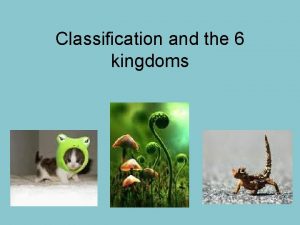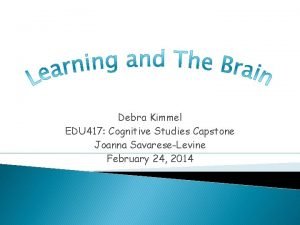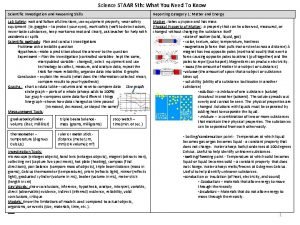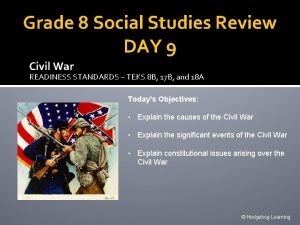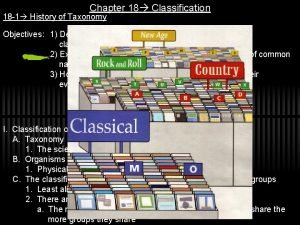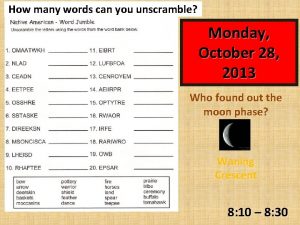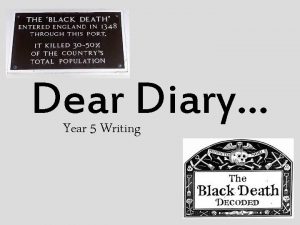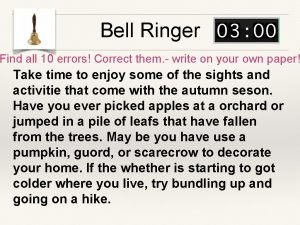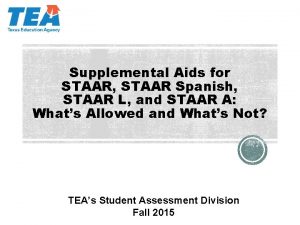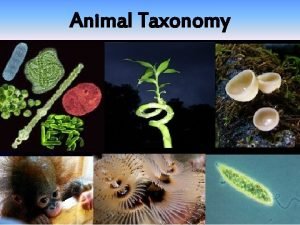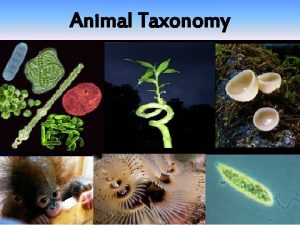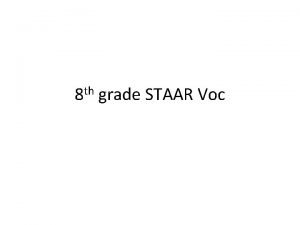Taxonomy Kingdoms STAAR Review Monday 417 Warm UP




























































































- Slides: 92

Taxonomy & Kingdoms STAAR Review

Monday 4/17 Warm UP


Monday 4/17 Warm UP Taxonomy Bionomial Nomenclature Genus Species

Classifying Organisms • Taxonomy – the science of classifying and grouping organisms. • Binomial Nomenclature – naming organisms using a two-part name. Both names are always italicized or underlined when they are written. – The name is always written in Latin HOW DO WE WRITE THE SCIENTFIC NAME OF AN ORGANISM? ? – First word is the Genus (always capitalized) – Second word is the Species (lower case)

Given the list of the taxonomic groups below, practice writing the scientific name of the organism on your paper. Taxa African Mantis Kingdom: Animalia Phylum: Arthropoda Class: Insecta Order: Montodea Family: Mantidae Genus: Sphodromantis Species: viridis Scientific Name

Given the list of the taxonomic groups below, practice writing the scientific name of the organism on your paper. Taxa African Mantis Kingdom: Anamalia Phylum: Arthropoda Class: Insecta Order: Montodea Family: Mantidae Genus: Sphodromantis Species: viridis Scientific Name Sphodromantis viridis

• Take a minute to write down the pneumonic below to remember the classification order on your handout. Kingdom Largest Phylum Class Order Family Genus Species Smallest King Phillip Came Over From Great Spain

Taxonomic Classification Most broad • least specific • Most general Least broad • Most specific • Least general

Taxa Cards • Try to put your taxa cards in order on your desk, from most inclusive to least inclusive. –Hint: Remember your pneumonic device

Taxa Races List the taxa order from most inclusive to least inclusive. Domain Kingdom Phylum Class Order Family Genus Species

Taxa Races What two taxa are used in binomial nomenclature.

Taxa Races What two taxa are used in binomial nomenclature. Genus Species

Taxa Races Arrange those words in the correct order for the scientific name.

Taxa Races What is the correct order for the scientific name. Genus Species

Taxa Races Which word is capitalized when writing the scientific name.

Taxa Races Which word is capitalized when writing the scientific name. Genus

Taxa Races Which word is lower-cased when writing the scientific name.

Taxa Races Which word is lower-cased when writing the scientific name. Species

Taxa Races Which word is italicized when writing the scientific name.

Taxa Races Which word is italicized when writing the scientific name. Genus Species

Prokaryote Cells that lack a nucleus – Bacteria Eubateria • Cell walls with peptidogylcan Archaebacteria • Cell walls without peptidogylcan • Live in extreme environments

Eukaryote Cells with a nucleus Protista Animalia Fungi Plantae

Autotroph Organism that makes its own food Eubacteria Protista Archaebacteria Plantae

Heterotroph Organism that must eat food Eubacteria Protista Fungi Archaebacteria Animalia

Binary Fission Asexual reproduction – cell splitting

• Fill out the vocabulary by matching the correct definition to the word on your handout. • Try to do this without using your notes!

• Fill out the vocabulary by matching the correct definition to the word on your handout. • Try to do this without using your notes! G D F C J I A H E B

6 Kingdoms • • • Eubacteria Archaebacteria Protista Fungi Plantae Animalia Prokaryotes – lack a nucleus Eukaryotes – have a true nucleus

Kingdoms Chart

Highlight On the following slides for each piece of information underlined, highlight it on your kingdoms chart.

Eubacteria & Archaebacteria • Includes all prokaryotes • Most are unicellular • Eubacteria have peptidoglycan and Archaebacteria DO NOT. • Eubacteria are found everywhere • Archaebacteria are extremophiles meaning live in extreme habitats (salt lakes, swamps)

Kingdom Protista • Eukaryotic • Unicellular & Multicellular • Most diverse group of all the kingdoms • Catchall kingdom • Ex: amoebas

Kingdom Fungi • • • Eukaryotic Heterotrophic Cell wall made of chitin Unicellular & Multicellular Many are decomposers Ex: mushrooms

Kingdom Plantae • Multicellular Eukaryotes • Photosynthetic • Cell walls made of cellulose, have chloroplasts • Autotrophs or Producers • Nonmotile (cannot move around)

Kingdom Animalia • Multicellular Eukaryotes • Consumers or Heterotrophs • Mobile – can move from place to place • No cell walls • Have tissues that are organized into organs and organ systems

Warm Up Tuesday 4/18 Complete this section on your notes from yesterday.

The Impossible Game Directions: 1. Players take turn reading the clues out loud to the group. They come up with their own final answer. Other group members can give hints to help guide them. 2. 3. 4. They check their answer on the back of the card. If you get the question right, roll the dice. If wrong, do not roll dice. Move the amount on the dice and do the first action of the color you land on. You only do the first color action, unless the second color action is to go back to start.

Classify This • Next are a series of descriptions for different organisms. • On your whiteboards, classify the Kingdom the organism belongs to. • Be prepared to justify your answer!

Classify This… • Reproduce sexually and asexually • Made up of one cell to many cells • Contains a nucleus • Receives food from external sources • Contains chitin

Classify This… Lichen – Fungi • Reproduce sexually and asexually • Made up of one cell to many cells • Contains a nucleus • Receives food from external sources • Contains chitin

Classify This… ✧Organism has a nucleus ✧Can be made of one cell or many ✧Make their own food or receive their food from outside sources ✧Reproduce Sexually & Asexually ✧Some have flagella

Classify This… Algae – Protista ✧Organism has a nucleus ✧Can be made of one cell or many ✧Make their own food or receive their food from outside sources ✧Reproduce Sexually & Asexually ✧Some have flagella

Classify This… ✧Contains no nucleus ✧Made up of one cell ✧Reproduce by Binary fission ✧Contain a cell wall and have no peptidoglycan ✧Some are extremophiles

Classify This… Halobacterium Salinarum– Archaebacteria ✧Contains no nucleus ✧Made up of one cell ✧Reproduce by Binary fission ✧Contain a cell wall and have no peptidoglycan ✧Some are extremophiles

Classify This… Feeds on bacteria Made of one cell Contains a nucleus Reproduces both sexually and asexually • Does not contain chitin • •

Classify This… Paramecium – Protista Feeds on bacteria Made of one cell Contains a nucleus Reproduces both sexually and asexually • Does not contain chitin • •

Classify This… Reproduces sexually Made up of many cells Nucleus Present Receives food from external sources • No cell wall • •

Classify This… Daphnia – Animalia Reproduces sexually Made up of many cells Nucleus Present Receives food from external sources • No cell wall • •

Classify This… • Circular shaped DNA that is not enclosed in a nucleus • Contains a cell wall that is made of peptidoglycan • Unicellular

Classify This… Cyanobacterium – Eubacteria • Circular shaped DNA that is not enclosed in a nucleus • Contains a cell wall that is made of peptidoglycan • Unicellular

Classify This… • Contains a nucleus • Made up of many cells • Reproduces asexually & sexually • Contains a cell wall made of chitin • Receives food from outside sources

Classify This… Aspergillus flavus– Fungi • Contains a nucleus • Made up of many cells • Reproduces asexually & sexually • Contains a cell wall made of chitin • Receives food from outside sources

Classify This… • Nucleus is absent • Made up of one cell • Reproduces using binary fission • Contains a cell wall that lacks peptidoglycan

Classify This… Methanogens – Archaebacteria • Nucleus is absent • Made up of one cell • Reproduces using binary fission • Contains a cell wall that lacks peptidoglycan

Classify This… • Nucleus is present • Consumes it’s food by phagocytosis • Single-celled • Cell wall not made of chitin

Classify This… Ameoba – Protista • Nucleus is present • Consumes it’s food by phagocytosis • Single-celled • Cell wall not made of chitin

Classify This… No cell wall Composed of many cells Reproduces sexually Receives food from external sources • Nucleus is present • •

Classify This… Sponge – Animalia No cell wall Composed of many cells Reproduces sexually Receives food from external sources • Nucleus is present • •

White Board Practice



Write the scientific name of this organism

Write the scientific name of this organism Dermochelys coricea

Write the scientific name of this organism

Write the scientific name of this organism Dionaea muscipula

Describe three characteristics of organisms that belong to the same kingdom as the organism below.

Describe three characteristics of organisms that belong to the same kingdom as the organism below. No cell wall Eukaryotic Multicellular Heterotrophic Motile

Describe three characteristics of organisms that belong to the same kingdom as the animal below.

Describe three characteristics of organisms that belong to the same kingdom as the organism below. Autotrophic Multicellular Cell wall made of cellulose Eukaryotic





Linnaeus’s System is Hierarchical Most Inclusive Kingdom Phylum Class Order Family Genus Least Inclusive Species Go to Section: Which of the following contains all of the others? a. Family c. Class b. Species d. Order

Linnaeus’s System is Hierarchical Most Inclusive Kingdom Phylum Class Order Family Genus Least Inclusive Species Go to Section: Which of the following contains all of the others? a. Family c. Class b. Species d. Order

Linnaeus’s System is Hierarchical Most Inclusive Kingdom Phylum Class Order Family Genus Least Inclusive Species Go to Section: Based on their names, you know that the baboons Papio annubis and Papio cynocephalus do not belong to the same: a. Family c. Order b. Genus d. Species

Linnaeus’s System is Hierarchical Most Inclusive Kingdom Phylum Class Order Family Genus Least Inclusive Species Go to Section: Based on their names, you know that the baboons Papio annubis and Papio cynocephalus do not belong to the same: a. Family c. Order b. Genus d. Species

Classification of Four Organisms Corn Whale Shark Humpback Whale Spider Monkey Kingdom Plantae Animalia Phylum Anthophyta Chordata Class Monocotyledones Chondrichthyes Mammalia Order Commelinales Squaliformes Cetacea Primates Family Poaceae Rhincodontidae Balaenopteridae Atelidae Genus Zea Rhincodon Megaptera Ateles Species mays typus novaeangilae paniscus Which two organisms shown in the table above are the most closely related? How do you know?

Classification of Four Organisms Corn Whale Shark Humpback Whale Spider Monkey Kingdom Plantae Animalia Phylum Anthophyta Chordata Class Monocotyledones Chondrichthyes Mammalia Order Commelinales Squaliformes Cetacea Primates Family Poaceae Rhincodontidae Balaenopteridae Atelidae Genus Zea Rhincodon Megaptera Ateles Species mays typus novaeangilae paniscus Humpback whale & Spider monkey Which two organisms shown in the table above are the most closely related? How do you know?









The bullfrog, Rana catesbeiana, is most closely related to the — F spotted chorus frog, Pseudacris clarki G Asian flying frog, Polypedates leucomystax H northern leopard frog, Rana pipiens J African bullfrog, Pyxicephalus adspersus

The bullfrog, Rana catesbeiana, is most closely related to the — F spotted chorus frog, Pseudacris clarki G Asian flying frog, Polypedates leucomystax H northern leopard frog, Rana pipiens J African bullfrog, Pyxicephalus adspersus


 Kingdoms taxonomy
Kingdoms taxonomy 6 kingdoms
6 kingdoms Marzano and kendall taxonomy
Marzano and kendall taxonomy Southwest flight 417
Southwest flight 417 Joanna savarese
Joanna savarese Cmsc417
Cmsc417 Cmsc 417
Cmsc 417 Department of transportation
Department of transportation Ece 417 uiuc
Ece 417 uiuc Cmsc 417
Cmsc 417 Cbe 417
Cbe 417 Campaign_id:417
Campaign_id:417 Ece 417
Ece 417 Internetwork
Internetwork Cbe 417
Cbe 417 Tax collector university
Tax collector university 11th grade us history staar review games
11th grade us history staar review games Staar review games
Staar review games Reporting category 3 earth and space
Reporting category 3 earth and space Staar science 8th grade review
Staar science 8th grade review Day 9 grade 8 social studies staar review
Day 9 grade 8 social studies staar review 5th grade science staar review
5th grade science staar review Anne of green gables staar answer key
Anne of green gables staar answer key Biology staar review
Biology staar review Biology staar review
Biology staar review Staar
Staar Section 18-1 review history of taxonomy
Section 18-1 review history of taxonomy Chapter review motion part a vocabulary review answer key
Chapter review motion part a vocabulary review answer key Writ of certiorari ap gov example
Writ of certiorari ap gov example Narrative review vs systematic review
Narrative review vs systematic review Narrative review vs systematic review
Narrative review vs systematic review Narrative review vs systematic review
Narrative review vs systematic review Monday tuesday wednesday thursday friday calendar
Monday tuesday wednesday thursday friday calendar Monday welcome back
Monday welcome back My favorite day is saturday
My favorite day is saturday What did you do last sunday?
What did you do last sunday? Sunday evening prayers
Sunday evening prayers Monday morning prayer
Monday morning prayer Art and music are my favorite subject
Art and music are my favorite subject Monday acrostic poem
Monday acrostic poem Past tense of on monday
Past tense of on monday Morning prayer at school
Morning prayer at school End of lesson dua
End of lesson dua Happy monday quizzes
Happy monday quizzes Monday.ocm
Monday.ocm Unscramble monday
Unscramble monday Happy monday team
Happy monday team Happy monday answer key
Happy monday answer key Happy fake monday
Happy fake monday Thursday before easter
Thursday before easter Happy monday afternoon images
Happy monday afternoon images Easter in poland
Easter in poland Monday question of the day
Monday question of the day Come monday morning
Come monday morning Monday math class
Monday math class Monday snacks
Monday snacks On monday and tuesday
On monday and tuesday Monday
Monday Monday tuesday wednesday thursday friday saturday sunday
Monday tuesday wednesday thursday friday saturday sunday Bell ringer monday mistakes
Bell ringer monday mistakes On monday vlad felt unwell
On monday vlad felt unwell You usually do your homework at night............
You usually do your homework at night............ Monday bell work
Monday bell work Fitt principle monday to friday
Fitt principle monday to friday Slidesmania
Slidesmania Monday bellwork
Monday bellwork Monday bellwork
Monday bellwork Difference between tone and mood
Difference between tone and mood Coming monday
Coming monday Good morning happy november
Good morning happy november Happy monday november
Happy monday november Happy monday november 1st
Happy monday november 1st Monday bellringer
Monday bellringer Monday bell ringer
Monday bell ringer Sunday monday a to z
Sunday monday a to z Marvelous monday terrific tuesday wonderful wednesday
Marvelous monday terrific tuesday wonderful wednesday Thursday bell ringers
Thursday bell ringers Happy monday answer
Happy monday answer Monday motivation prayer
Monday motivation prayer Monday bellwork
Monday bellwork Happy monday jr password
Happy monday jr password Homework for monday
Homework for monday Toeic test
Toeic test Moday tuesday
Moday tuesday December morning message
December morning message Portuguese sailor
Portuguese sailor What did you do last weekend conversation
What did you do last weekend conversation The very hungry caterpillar stomachache
The very hungry caterpillar stomachache Sunday monday 27
Sunday monday 27 Monday friday
Monday friday Sunday monday tuesday thursday friday saturday
Sunday monday tuesday thursday friday saturday Monday.ocm
Monday.ocm Sunday monday letters
Sunday monday letters
